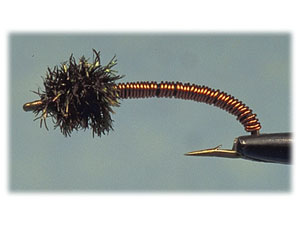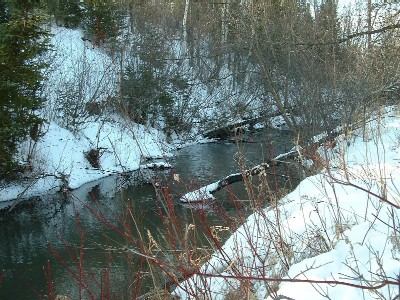
If you're of one of those fly fishers who packs away the gear at the first sign of snow, you're missing out on a very special type of fishing. Unknown to some fly anglers is the fact that, during the winter months, there is a secret hatch of tiny insects that can make the long winter loads of fun for fly anglers.
 |
| The well-known Brassie is a staple midge pupa pattern. |
Midges are aquatic insects that some fly anglers believe are impractical to imitate due to their small size. The truth of the matter is, midges in the adult and larval stages make up only a very small portion of the trout's respective diet; however, with the scarcity of food during the cold winter months, even tiny flies become a sought after food source by hungry trout.
When looking streamside for hatches of midges, don't expect to see large, dense flies hovering above the water surface. Adult midges are tiny, secretive insects that typically hatch in small numbers and are barley noticeable to the untrained eye. For fly anglers, though, learning to key on these critters mid-winter can be the difference between landing your limit and catching a cold.
Midge Larvae
Although the majority of fly fishermen dream of casting dries to large surface feeding trout, this just isn't always the best way to catch fish, especially mid-winter. When sampling the stomachs of trout caught during the winter months, you'll find the regular aquatic nymphs and worms, but the dominate food source present should be midge larvae.
Midge larvae live along the bottom of the stream hiding under any rock or cover that they can find to protect themselves from feeding predators and current. If these tiny insects happen to get disturbed from their resting place and swept into the current, they will drift helplessly down stream until either coming back into contact with the bottom or falling prey to a hungry trout.
Midge larvae are very small, dark, thin-bodied critters, so picking a good fly to use should incorporate these special characteristics. Patterns tied on 18-24 size hooks using black flosses and tiny tinsel ribbing seem to be the standard, with a small tuft of white CDC or ice dubbing to create a visible thorax.
To fish these larval patterns, the fly angler needs to have extreme patience during drifts. Winter midge fishing is not similar to any other nymph tactic because fish do not aggressively search out food this time of year. This forces the angler to almost contact the trout with the fly in order to get a strike. This is very much unlike warm water fishing, where trout will actively search out and forage on anything drifting downstream that looks appealing.
When fishing midge larval patterns, use an upstream and across presentation, positioning your fly above turbulent water or a fishy looking run. As the fly begins to drift downstream, it's very important for anglers to mend fly line so that no drag is placed on the fly, allowing it to sink uninhibited. One good point to remember is that when fishing midge subsurface presentations, fish won't usually strike flies on the first drift. It takes numerous drifts and patience to fish these types of patterns successfully. It is not uncommon to run your midge pattern 5 to 8 times through the same run the same way, only to get the take from fish on the very last drift.
Adult Dry Flies
 |
| Don't let snow-covered grounds keep you from fly fishing. |
If you're lucky enough to wander out into the ice-cold river and find adult midges hatching or returning to the river, you can exploit this opportunity to catch large numbers of nice trout. During midge hatches, you shouldn't expect to see adult flies hatching and sitting on the waters surface. In most cases these insects spend very little time on the water surface unless foul weather conditions hinder their progress.
In cold, wet conditions, emerging midge adults will have a hard time drying their wings, leaving them struggling helplessly on the surface. Ideally, dry-fly fishermen should look for a small cloud of midges flying low to the waters surface. Because midges are so tiny, trout will rarely feed on individual flies since the return on investment for eating single flies is so small. These predators would rather come to the surface where they can take a dozen or so flies in one swoop.
Heavily hackled, dark-bodied, dry-fly patterns do a good job when trying to imitate these small clusters of midges. The many tiny hackle barbs look very similar to the many little wings of midges holding tightly together. Size 14 to 24 dry flies seem to be the standard amongst anglers, but catching a few of the real adult's streamside will best alert you to the best fly size.
Actual midge clusters on the water surface will not just drift downstream motionless. These flies twitch and dance enticingly downstream, attracting hungry trout below. Dry-fly anglers should use standard dry-fly tactics to create drag free drifts, as well as incorporate small line strips into the retrieve to add an occasional hop or bounce to the fly.
Tackle Considerations
Traditionally, midge fishing requires long, thin, sensitive rods in order to feel the fish pick up small flies on light line. A 9 foot 3-weight or 4-weight rod works great for midge fishing small rivers; 9 foot 5-weights are excellent for larger bodies of water.
Weight-forward floating line is ideal for midge presentations because it allows anglers to fish both dry fly and larval imitations with ease. Since these flies are extremely small, very small tippet and leader sizes are necessary to allow the flies to act normally on the water's surface. 6X tippets are used for larger flies (size 14-18) while 7X tippets are used for smaller flies (size 18-24).
Setting the Hook
Another thing to remember is that, when a fish hits your fly, do not set the hook with the rod as you normally would while fishing with larger flies; this will most likely pull the tiny hook free from the fish's mouth or break your tippet. Instead, slowly raise the rod and remove the slack from the line with your free hand until you feel the weight of the fish. This method should increase your hook up numbers as well as the number of fish landed.
While the weather outside may be a bit frightful, the educated fly fisherman should recognize the great opportunity winter midge fishing provides. Decreased fishing pressure, along with lack of hatching insects, makes fly fishing with midge patterns during the winter months a very productive and fun way to catch trout. A little bit of patience, some confidence and a willingness to try new patterns and different techniques should have anglers fighting fish in a winter wonderland.
- 5190 views

